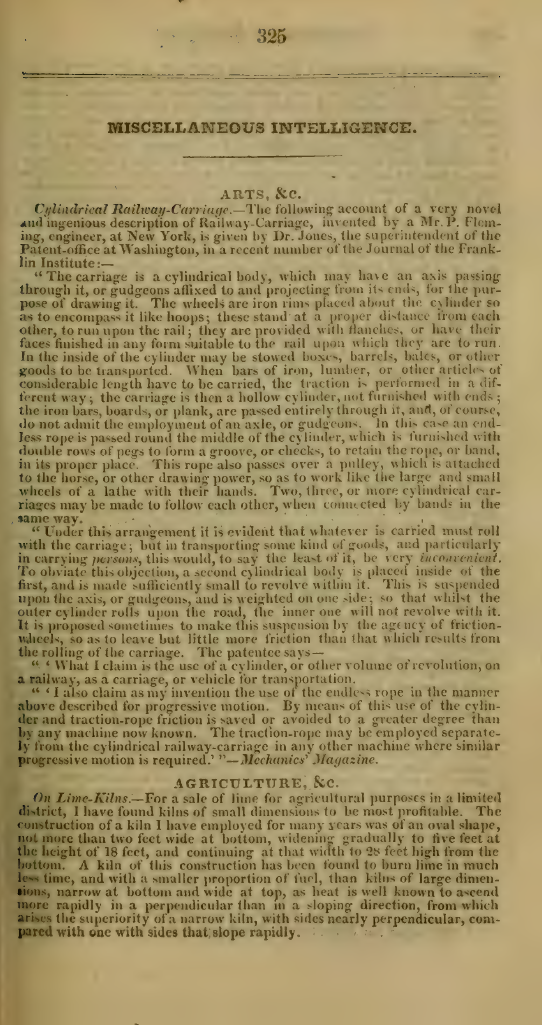Miscellaneous Intelligence
DOI:
https://doi.org/10.21504/saqj.13.2656Keywords:
Railway Carriage, Cylindrical Railway-Carriage, P. Fleming, Lime Kiln Construction, Mr. Menteath, Oleaginous Plants, Lucerne Cultivation (Scotland), Medicago sativa, Mr. Cunninghame, Libellula, Dr. Villermé, Human Pathology, Animal diseaseAbstract
This section of miscellaneous intelligence encompasses a diverse range of topics across the Arts, Agriculture, Natural History, and Medicine.
Arts & Engineering-
Cylindrical Railway-Carriage: An invention by Mr P. Fleming of New York, described by Dr Jones. The carriage uses a hollow cylinder with external iron rims/hoops for wheels. Goods can be stowed inside, or long materials (like bars or lumber) can pass through it. Traction sometimes uses an endless rope mechanism to save friction. For passenger transport or goods that must not revolve, a weighted inner cylinder is suspended on the axis to remain stationary while the outer cylinder rolls, though this returns somewhat to the ordinary wagon principle.
-
Lime Kilns: Mr Menteath advocates for narrow kilns with nearly perpendicular sides (in the shape of an egg or oval) as they burn lime more quickly and efficiently, yielding approximately three measures of lime shells for every measure of coal, compared to wide kilns that require nearly one measure of coal for every two measures of lime.
-
Oleaginous Plants: Discusses the importance of fixed oils (Olive, Nut, and seed oils) derived from plants like the olive, rape, poppy, and flax. It notes that cultivation of oleaginous herbs often exhausts the soil, but the remaining oil cake serves as excellent manure due to the presence of azote.
-
Lucerne in Scotland: Mr Cunninghame reports that Lucerne (Medicago sativa) thrives best on deep, soft loam or any dry soil with a loose subsoil. It is a valuable fodder crop and an effective substitute for tares. He claims an acre of lucerne produces at least one-third more green food or hay than clover and rye-grass.
-
Dragon Flies (Libellula): Describes the highly predatorial habits of the insect in its perfect (aerial) state, and its fascinating aquatic nymph stage. The nymph is noted for its unique mode of locomotion via ejecting a jet of water from its anal/respiratory extremity (functioning as a syringe and piston) and the final metamorphosis process.
-
Stature of Men in France: Dr Villermé's memoir demonstrates that, ceteris paribus, human stature is generally higher in wealthy countries and cities than in poorer/rural areas. In the Allier department, 55 out of 100 young men were under 4 feet 10 inches, compared to only 8 out of 100 in the richer Doubs department, significantly skewing conscription chances.
-
Anomalous Animal Appearance: Joseph E. Muse recounts two instances on his farm near Cambridge, where fish (Perch species, 4 to 15 inches long) appeared in a recently dug, elevated ditch with no surface water connection. A separate account provides medical testimony of a young woman who vomited four live/recently dead salamander lizards (erroneously called "ground puppies," genus Lacerta), which she was inferred to have swallowed in their nascent state while frequently drinking swamp water.
-
Human Pathology: The section concludes by advocating for the experimental study of animal diseases to advance the understanding and treatment of human pathology, emphasising that animal subjects allow for the study of morbid phenomena under the action of diverse medicines.
Downloads

